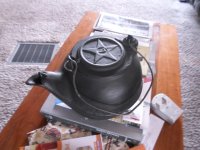Undoubtedly a very nice restoration which shows us what we can do if we put our minds to it.
Couple things....I would have thought that the kettle would have had some sort of handle rather than just the wire as shown. I may be wrong but if that thing weighs as much as I think it does it would seem like there would have been some sort of bending over the years of repeated lifting and pouring from it. It would have been a little cumbersome to handle with a small wire in your hand even with a pot holder. I'm betting there was either a wooden handle on it or perhaps an "Alaskan" type coil wire handle.
Food for thought....Have you tried searching the data base at the Library of Congress Prints & Photographs Division? They have thousands if not more of photographs dating back to 1815 when the library was established.
Again...Nice piece and good restoration.
Couple things....I would have thought that the kettle would have had some sort of handle rather than just the wire as shown. I may be wrong but if that thing weighs as much as I think it does it would seem like there would have been some sort of bending over the years of repeated lifting and pouring from it. It would have been a little cumbersome to handle with a small wire in your hand even with a pot holder. I'm betting there was either a wooden handle on it or perhaps an "Alaskan" type coil wire handle.
Food for thought....Have you tried searching the data base at the Library of Congress Prints & Photographs Division? They have thousands if not more of photographs dating back to 1815 when the library was established.
Again...Nice piece and good restoration.



